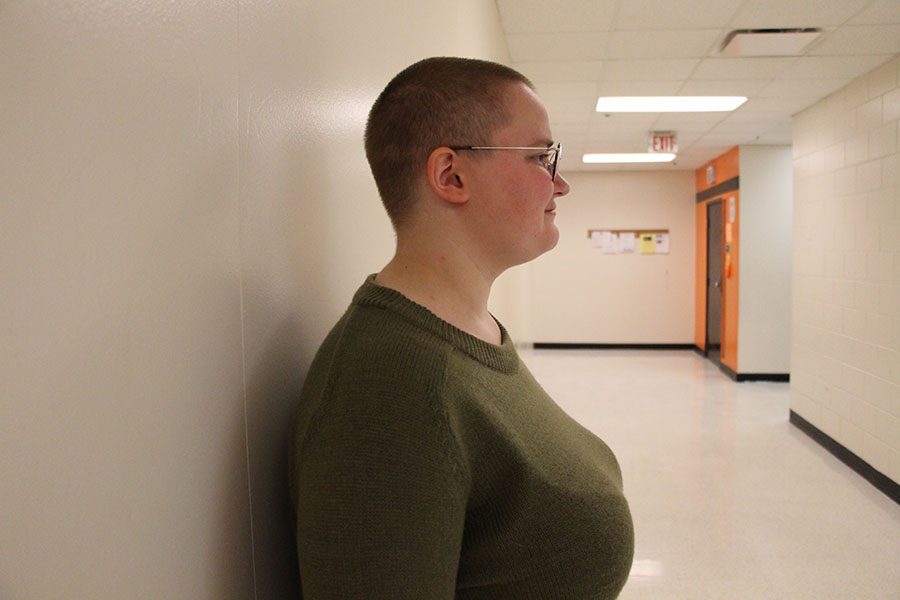At South, hairstyles are strong part of identity
Junior Tyler Jacobson has a hairstyle some might say is unusual, a shaved head. Jacobson explained that his hairstyle helps represent a part of his identity. “I have a masculine part in me but I dress like a female because I like female style. My hairstyle identifies my masculine part, and I think that I need to have a part of my body that identifies it,” he explained.
November 28, 2016
What identifies a person?
The way that a person dresses, speaks, and yes, does their hairstyle is something that shows a part of what that person is like. Hairstyle is one of the key elements of every person’s look, and hairstyles often express the personality of the wearer.
Sometimes when people drastically change their haircut it’s because they are looking for a big change in their lives. People dye their hair red, yellow, green, or purple. Girls cut their hair short and boys let their hair grow long. There is a lot of freedom in hairstyles and it tends to fully reflect people’s personalities.
When many South students’ grandparents and great-grandparents were young, many girls who had colored or very short hair were seen as a rebels or weird. People could not express themselves for fear of being judged, beaten or marginalized. Now there is more freedom than in the past century, but there are still stereotypes and judgement. For example, there are stereotypes of people who do not show their hair like Muslim women who wear a hijab.
“People use [hairstyles] to express themselves and there are many different types of style,” said senior Muna Ali, who wears a hijab. She wears a hijab to express herself and to represent her religion.
She also said that she liked to change her hijab depending on the mood that she is in. However, there are misconceptions due to wearing a hijab: “Sometimes, when you wear a hijab there are…people who believe that you don’t have any hair, which is not true,” Muna explained. Muna concluded saying that in her opinion hairstyles doesn’t identify a gender and that people can have any hairstyle no matter what gender they are.
Then how does hair style reflect what gender someones has? There are a lot of stereotypes about different types of hairstyles and the genders they represent.
“There is a feminine style and a masculine style but there isn’t a dress code and in my opinion everyone is free to dress and have a hairstyle that identifies him or herself,” said junior Tyler Jacobson. “Don’t judge a book by its cover, people do that all the time, we have a cover and I think our style is supposed to be our cover,” continued Jacobson, who people often perceive as female and has a shaved head.
Jacobson’s hairstyle is unique but some people might think it’s strange. However, he doesn’t care about the judgement. “There is always a lot of pressure, but people can dress and have hairstyle as they want. They don’t have to listen to different opinions or judgement but just be themselves and be whatever they want to be,” explained Jacobson. “The way in which people perceive us is also given by hairstyle. I have a masculine part in me but I dress like a female because I like female style. My hairstyle identifies my masculine part and I think that I need to have a part of my body that identifies it.”
It’s common for people to assume gender based on a person’s hair but for people who identify as genderfluid this can be wrong.
Being genderfluid can mean different things to different people. A general definition is when a person’s gender identity changes from day to day sometimes being more feminine or masculine, sometimes being both or sometimes being neither.
“People think negative things about my gender and there are a lot of stereotypes, people used to think that a genderfluid person can’t exist,” says freshmen Core Barnhill, who is genderfluid. They said that they can feel judged by by other people. Despite this, Barnhill tries to combat stereotypes: “I speak out a lot with people and I stand up for myself and for other people and I presenting myself as me,” they said.
Barnhill said that they only care about what people think when it is supportive and when there is solidarity about being genderfluid, and they don’t care a lot about negative judgement.
Some advice Barnhill gives to genderfluid people, as well as to all people who feel hurt by stereotypes, and who are unable to express themselves fully is: “Don’t be afraid to be yourself, just be you.”





